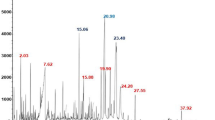Abstract
In search of a natural larvicide, petroleum ether, carbon tetrachloride, and methanol extracts of Azadirachta indica fruits and seed extracts of bitter gourd (Momordica charantia) and castor (Ricinus communis) were tested for larvicidal activity against Culex quinquefasciatus. Among the extracts tested, the methanol extract of Az. indica was observed the most potent with LC50 at 74.04 and 58.52 ppm and LC−90 at 201.83 and 171.70 ppm as compared to methanol extract of M. charantia with LC50 at 101.18 and 93.58 ppm and LC90 at 322.81 and 302.62 ppm carbon tetrachloride extract of R. communis with LC50 at 144.11 and 92.44 ppm and LC90 at 432.42 and 352.89 ppm after 24 and 48 h, respectively. The methanol extract of Az. indica exhibited potential results and can be exploited as a preferred natural larvicide for the control of filarial vector, Cx. quinquefasciatus.


Similar content being viewed by others
References
Abbot WS (1925) A method of computing the effectiveness of an insecticide. J Econ Entomol 8:265–267
Batabyal L, Sharma P, Mohan L, Maurya P, Srivastava CN (2007) Larvicidal efficiency of certain seed extracts against Anopheles stephensi, with reference to Azadirachta indica. J Asia Pacific Entomol 10:251–255
Bernhard L, Bernhard P, Magnussen P (2003) Management of patients with lymphoedema caused by filariasis in north-eastern Tanzania: alternative approaches. Physiotherapy 89:743–749
Bowers WS (1992) Biorational approaches for insect control. Korean J Applied Entomol 31:289–303
Finney DJ (1971) Probit analysis, 3rd edn. Cambridge University Press, Cambridge
Grover JK, Yadav SP (2004) Pharmacological actions and potential uses of Momordica charantia: a review. J Ethnopharmacol 93:123–132
Gubler DJ (1998) Resurgent vector borne diseases as a global health problem. Emerg Infect Dis 4:442–450
James AA (1992) Mosquito molecular genetic: the hands that feed bite back. Science 257:37–38
Mohan L, Sharma P, Srivastava CN (2005) Evaluation of Solanum xanthocarpum extracts as mosquito larvicides. J Environ Biol 26:399–401
Mohan L, Sharma P, Srivastava CN (2006) Evaluation of Solanum xanthocarpum extract as a synergist for cypermetrin against larvae of the filarial vector, Culex quinquefasciatus (Say). Entomol Res 36:220–225
Mulla MS, Su T (1999) Activity and biological effects of neem products against arthropods of medical and veterinary importance. J American Mosq Control Assoc 15:133–152
Ndione RD, Faye O, Ndiaye M, Dieye A, Afoutou JM (2007) Toxic effects of neem products (Azadirachta indica A. Juss) on Aedes aegypti Linnaeus 1762 larvae. Afr J Biotechnol 6:2846–2854
Obomanu FG, Ogbalu OK, Gabriel UU, Fekarurhobo GK, Adediran BI (2006) Larvicidal properties of Lepidagathis alopecuroides and Azadirachta indica on Anopheles gambiae and Culex quinquefasciatus. Afr J Biotechnol 5:761–765
Poonam S, Sharma JD (1998) Plants showing antiplasmodial activity from crude extracts to isolated compounds. Indian J Malariol 35:57–110
Prabakar K, Jebanesan A (2004) Larvicidal efficacy of some cucurbitaceous plant leaf extracts against Culex quinquefasciatus (Say). Bioresour Technol 95:113–114
Prajapati V, Tripathi AK, Aggarwal KK, Khanuja SPS (2005) Insecticidal, repellent and oviposition-deterrent activity of selected essential oils against Anopheles stephensi, Aedes aegypti and Culex quinquefasciatus. Bioresour Technol 96:1749–1757
Prakash A, Rao J (1997) Botanical pesticides in agriculture. CRC Lewis, New York, p XIII
Rao DR, Reuben R (1989) Evaluation of neem cake power and neem cake coated urea as mosquito larvicides in rice fields. In: Uren MF, Block J, Manderson LH (eds) Arbovirus research in Australia. Proc Fifth Symp 28 Aug to 1 Sept 1989. Brisbane, Australia, CSIRO Trop Animal Sci 138–142
Rahuman AA, Venktesan P (2008) Larvicidal efficacy of five cucurbitacious plant leaf extracts against mosquito species. Parasitol Res 103:133–139
Reddy PJ, Krishna D, Murthy US, Jamil K (1992) A microcomputer FORTRAN program for rapid determination of lethal concentration of biocides in mosquito control. CABIOS 8:209–213
Ruskin FR (1992) Neem: a tree for solving global problems. National Academy Press, Washington DC
Saxena RC, Jayashree S, Padma S, Dixit OP (1994) Evaluation of growth disrupting activity of Ageratum conyzoides crude extract on Culex quinquefasciatus (Diptera: Culicidae). J Environ Biol 15:67–74
Service MW (1983) Management of vectors. In: Youdeowei A, Service MW (eds) Pest and vectors management in tropics. Longman, London, pp 265–280
Sharma VP, Dhiman RC (1993) Neem oils as a sandfly (Diptera: Psycodidae) repellent. J American Mosq Control Assoc 9:364–366
Sharma P, Mohan L, Srivastava CN (2004) Larval susceptibility of Ajuga remota against anopheline and culicine mosquitoes. Southeast Asian J Trop Med Public Health 35:608–610
Sharma AK, Kalpana B, Bhardwaj AC (2005a) Mosquito larvicidal characteristics of certain phytoextracts. J Exptl Zool India 8:109–112
Sharma P, Mohan L, Srivastava CN (2005b) Larvicidal potential of Nerium indicum and Thuja orientelis extracts against malaria and Japanese encephalitis vector. J Environ Biol 26:67–70
Sharma P, Mohan L, Srivastava CN (2006) Phyto-extract induced developmental deformities in malaria vector. Bioresour Technol 97:1599–1604
Singh SP, Raghavendra K, Singh RK, Subbarao SK (2002) Studies on larvicidal properties of leaf extract of Solanum nigrum Linn (Family: Solanaceae). Curr Sci 81:1529
Vatandoost H, Vaziri VM (2004) Larvicidal activity of a neem tree extract (Neemarin) against mosquito larvae in the Islamic Republic of Iran. East Mediterranean Health J 10:573–581
WHO (1975) Instructions for determining the susceptibility or resistance of mosquito larvae to insecticides. Mimeographed Document WHO/VBC/75-583
WHO (1986) Resistance of vectors and reservoirs of diseases to pesticides. Tenth report of WHO Expert Committee on Vector Biology and Control Technical Series 737: 75–85
Author information
Authors and Affiliations
Corresponding author
Rights and permissions
About this article
Cite this article
Batabyal, L., Sharma, P., Mohan, L. et al. Relative toxicity of neem fruit, bitter gourd, and castor seed extracts against the larvae of filaria vector, Culex quinquefasciatus (Say). Parasitol Res 105, 1205–1210 (2009). https://doi.org/10.1007/s00436-009-1541-7
Received:
Accepted:
Published:
Issue Date:
DOI: https://doi.org/10.1007/s00436-009-1541-7




